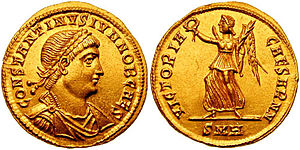
Back Economia de l'Imperi Romà Catalan Wirtschaft im Römischen Reich German Economía de la Antigua Roma Spanish Rooman valtakunnan talous Finnish Économie romaine French Տնտեսագիտական միտքը Հին Հռոմում Armenian Ekonomi Romawi ID Economia romana Italian Economia de Roma Antica LFN Economia do Império Romano Portuguese

The study of the economies of the ancient city-state of Rome and its empire during the Republican and Imperial periods remains highly speculative. There are no surviving records of business and government accounts, such as detailed reports of tax revenues, and few literary sources regarding economic activity. Instead, the study of this ancient economy is today mainly based on the surviving archeological and literary evidence that allow researchers to form conjectures based on comparisons with other more recent pre-industrial economies.
During the early centuries of the Roman Republic, it is conjectured that the economy was largely agrarian and centered on the trading of commodities such as grain and wine.[2] Financial markets were established through such trade, and financial institutions, which extended credit for personal use and public infrastructure, were established primarily by interfamily wealth.[3] In times of agricultural and cash shortfall, Roman officials and moneyers tended to respond by coining money, which happened during the prolonged crisis of the First Punic War and created economic distortion and difficulties.
Following the Punic Wars, during the late Republic and the early Roman Empire, the economy became more monetized and a more sophisticated financial system emerged.[4] Emperors issued coinage stamped with their portraits to disseminate propaganda, to create public goodwill, and to symbolize their wealth and power.[5] The Roman Imperial monetary economy often suffered bouts of inflation in part by emperors who issued money to fund high-profile imperial projects such as public building works or costly wars that offered opportunities for propaganda but little or no material gain.[4]
Emperors of the Antonine and the Severan dynasties overall debased the currency, particularly the denarius, under the pressures of meeting military payrolls.[6] Sudden inflation during the reign of Commodus damaged the credit market.[7] In the mid-200s, the supply of specie contracted sharply.[8] Conditions during the Crisis of the Third Century, such as reductions in long-distance trade, the disruption of mining operations, and the physical transfer of gold coinage outside the empire by invading enemies, greatly diminished the money supply and the banking sector by the year 300.[9] Although Roman coinage had long been fiat money or fiduciary currency, general economic anxieties came to a head under Aurelian, and bankers lost confidence in coins legitimately issued by the central government. Despite Diocletian's introduction of the gold solidus and monetary reforms, the credit market of the Empire never recovered its former robustness.[7]
- ^ J. Rufus Fears, "The Theology of Victory at Rome: Approaches and Problem," Aufstieg und Niedergang der römischen Welt II.17.2 (1981), pp. 752 and 824, and in the same volume, "The Cult of Virtues and Roman Imperial Ideology," p. 908.
- ^ Garnsey, Peter, et al. The Roman Empire: Economy, Society and Culture. 2nd ed., University of California Press, 2015, www.jstor.org/stable/10.1525/j.ctt9qh25h.
- ^ Temin, Peter. “Financial Intermediation in the Early Roman Empire.” The Journal of Economic History, vol. 64, no. 3, 2004, pp. 705–733., www.jstor.org/stable/3874817.
- ^ a b Andreau, Banking and Business in the Roman World, p. 2; Harris, "The Nature of Roman Money," n.p.
- ^ Bond, Shelagh (October 1957). "The Coinage of the Early Roman Empire". Greece & Rome. 4 (2): 149–159. doi:10.1017/S001738350001593X. JSTOR 642136. S2CID 163277451.
- ^ Harl, Coinage in the Roman Economy, 300 B.C. to A.D. 700, p. 125–136.
- ^ a b Harris, "The Nature of Roman Money," in The Monetary Systems of the Greeks and Romans, n.p.
- ^ Harl, Coinage in the Roman Economy, 300 B.C. to A.D. 700, pp. 128–129.
- ^ Harris, "The Nature of Roman Money," in The Monetary Systems of the Greeks and Romans, n.p.; Harl, Coinage in the Roman Economy, 300 B.C. to A.D. 700, pp. 128–129.